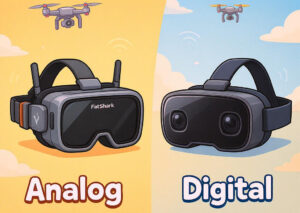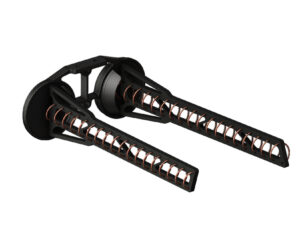If you’re into FPV drones, you know that a crisp, reliable video feed is everything. Whether you’re racing around tight corners or cruising long distances, your antennas play a huge role in keeping you connected to your drone. But here’s a question we get all the time:
“Do I need different antennas for digital and analog FPV systems?”
The short answer? No!
That’s right—antennas don’t care if your system is digital or analog. As long as they’re tuned to the right frequency (usually 5.8GHz for FPV), they’ll work just fine for both. But let’s break it down so you understand why—and while we’re at it, we’ll compare digital and analog systems to help you pick the best one for your flying style.
How Do FPV Antennas Actually Work?
Think of your antenna like a two-way radio. Its job is simple:
- On the drone – The antenna sends out your live video feed.
- On your goggles – The antenna picks up that signal so you can see what your drone sees.
Whether your system is digital or analog, the antenna’s role stays the same. It just needs to be optimized for 5.8GHz, the standard frequency for FPV video.
Pro Tip: A well-made antenna will work great for both digital (like DJI, HDZero, or Walksnail) and analog systems. The key is getting one with good gain, durability, and the right polarization (more on that later).
Digital vs. Analog FPV: Which One Should You Choose?
Both systems have pros and cons, so let’s compare them side by side.
🔹 Analog FPV – The Classic Choice
✔ Pros:
- Super low latency – Almost instant video, perfect for racing.
- Cheaper – Great for beginners or budget flyers.
- Gradual signal fade – When you’re losing signal, it gets fuzzy first (giving you time to react).
- Wide compatibility – Mix and match gear from different brands.
✖ Cons:
- Lower video quality – Grainy, staticky, and not HD.
- Limited range – More prone to interference.
Best for: Racers, freestyle pilots on a budget, or anyone who loves the simplicity of analog.
🔹 Digital FPV – The Future is Here
✔ Pros:
- Crystal-clear HD video – No static, just smooth footage.
- Better range & penetration – Handles interference well.
- Extra features – Some systems (like DJI) offer DVR recording, customizable OSD, and more.
✖ Cons:
- Slightly higher latency – Not ideal for ultra-competitive racing.
- More expensive – Higher upfront cost and proprietary parts.
- Sudden signal drops – Instead of fading, the feed can cut out abruptly.
Best for: Cinematic flyers, long-range explorers, and pilots who want the best video quality.
Why the Same Antennas Work for Both Systems
Here’s the cool part: antennas don’t care about signal type. They just transmit and receive radio waves at the right frequency.
- Digital signals? The antenna sends the 1s and 0s.
- Analog signals? The antenna sends the continuous wave.
As long as your antenna is well-tuned for 5.8GHz, it’ll work with DJI, HDZero, Walksnail, or any analog VTX.
Want the best performance? Look for:
✅ High-quality materials (like durable SMA connectors)
✅ Good gain (for better range)
✅ Right polarization (RHCP or LHCP, depending on your setup)
Top Antenna Picks for Your FPV Drone
Since antennas are universal, here are two great options from our shop that work with both digital and analog systems:
- ProDrone Ultra-Light 5.8GHz Antenna – Perfect for racers who need a lightweight, durable antenna with great signal clarity.
- ProDrone Long-Range RHCP Antenna – Ideal for long-range pilots who want maximum penetration and reliability.
Final Verdict: Digital or Analog?
Still undecided? Here’s a quick cheat sheet:
- Go Analog if: You race, fly freestyle on a budget, or love the simplicity.
- Go Digital if: You want HD video, fly long-range, or don’t mind spending extra for premium quality.
And remember—no matter which system you choose, a good antenna makes all the difference!
Ready to upgrade your FPV setup? Check out our FPV antenna collection and find the perfect match for your drone!


